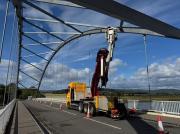Council Welcomes Forward-thinking Report On Coastal Change For Golspie To Coul
27th August 2021
The Highland Council has today (27 August 2021) welcomed Scottish Government's publication of a forward-thinking report on coastal change for the area in East Sutherland stretching from Golspie to Coul. It provides a summary of the latest ‘Dynamic Coast' science and is intended to support key partners in developing and implementing a response, which could include resilience and adaptation measures.
Highland's diverse coastline is one of its greatest assets. The coastal zone hosts many towns and villages where people live and work, lifeline transportation links, key infrastructure, employment bases, agriculture, and biodiversity, while also being a place of leisure, recreation and tourism and many other activities.
The beaches, dunes and shores of Highland are particularly vulnerable to the erosive power of the sea. The impacts of climate change - particularly rising sea levels and more frequent and powerful storms - increases those forces of change on the coastal areas. However, the effects Highland might expect will vary depending upon the site-specific circumstances and the rate of climate change itself.
Councillor Trish Robertson, Chair of the Economy and Infrastructure Committee and Climate Change Working Group, said: "I welcome the publication of this report for bringing much needed data that should enable better understanding of impacts of Climate Change and of some measures that we and others can consider taking in response."
More detailed consideration and assessment will be required, not only by the Council but also other organisations, businesses, and individuals - before deciding what specific proposals or measures to bring forward and before making decisions. The Council is beginning to consider how best to make use of this latest report in the context of its various functions and responsibilities in respect of coastal erosion, flooding, climate change adaptation, development planning and management. There will be other vulnerable parts of Highland's coast that may benefit from similar modelling and analysis for coastal erosion and associated flooding, to likewise inform future policy and practice.
The latest Dynamic Coast report will also be of considerable interest to the local communities. Community group Go Golspie was recently awarded £80,000 from the Highland Coastal Communities Fund by the Council's Sutherland County Committee, towards restoration of Golspie's breakwater.
As explained on the Dynamic Coast website , the project is a pan-government partnership that has transformed Scotland's public sector's understanding of coastal change. The initial research spanned from January 2015 to March 2017. The aim was to establish an evidence base of national coastal change, summarising the last 130 years of coastal change across all of Scotland's erodible shores (beaches, dunes, and saltmarshes) and projected the changes forward to 2050. A number of organisations around Scotland are already making use of that initial research, for example The Highland Council is using it at a strategic level within the current review of the Inner Moray Firth Local Development Plan as one of a number of data sources informing which sites to prefer for development.
In 2018 a second phase of Dynamic Coast research was commissioned in Scotland, to consider multiple research questions including: the extent and resilience of natural coastal flood protection features; climate change accelerations; technological improvements and the development of adaptation and resilience plans at 7 ‘super sites'. The stretch of coastline from Golspie to Coul (but not including the Loch Fleet tidal basin coast) was one of the ‘super sites' identified for this work and which has now led to the recently published report, based on more detailed assessment than was included in the initial research.
If nothing is done, there will be some areas where the land uses and activities in the coastal zone will be adversely affected by coastal erosion and associated flooding, in years to come. The Dynamic Coast project has previously, broadly identified types of coastal risk management and adaptation that are available. These, it explains, lie along a spectrum: from ‘doing nothing or non-active intervention’; ‘accommodate erosion’ by adapting development plans and relocating existing assets; ‘erosion resist’ either using traditional engineering structures or nature-based solutions, such as beach feeding; and by ‘advancing the coast’ seawards, perhaps using artificial offshore structures or large-scale beach feeding (e.g. mega nourishment such as a sand motor). The latest report suggests how those could apply in the Golspie and Coul area, based on more detailed modelling of scenarios and understanding for that area.
Full Report HERE
Related Businesses
Related Articles
Exciting Career Opportunities With The Highland Council Now Open For Applications
# 10 December 2025 Career opportunities with The Highland Council The Highland Council is looking to fill a variety of posts relating to civil engineering and flood risk management based in locations across the area. Included are opportunities specifically for civil engineering graduates and technicians, providing the ideal job with career progression for anyone recently qualified and ready for a varied and interesting role.
What the NC500 Research Projects Are Designed to Do - and Why They Matter for the Highlands
As the North Coast 500 approaches its tenth anniversary, it has become one of Scotland's most well-known tourism success stories. The 516-mile loop around the far north of the Highlands has been celebrated internationally, marketed as a world-class road trip, and credited with transforming visitor numbers in some of Scotland’s most remote areas.Help Shape the Future of Thurso
The Highland Council is inviting people that live, work, or study in Thurso, to come along to the public consultation events to have their say. This is an opportunity to help shape the future of Thurso, to gather views and ideas.
Are Scottish Councils Quietly Reversing Outsourcing? A Look at Insourcing, Cuts and the Highland IT Shift
A notable article in the Guardian on 6 December 2025 noted the high sums being paid by London councils outsourcing services to private firms. The article starts with the reduction in council funding by UK government since 2010.Council welcomes Visitor Levy flexibility plan
The Highland Council welcomes moves by the Scottish Government to introduce greater flexibility on how it could design a Visitor Levy Scheme for consultation. The Visitor Levy (Scotland) Act 2024 currently provides local authorities with discretionary powers to implement percentage-based levies following statutory consultation.Highland Council is reaching out for views to shape its next 26/27 budget.
As it looks to set out its forthcoming priorities, the council is seeking involvement from members of the public, including businesses, community groups, parents, and young people. All their opinions are going to be crucial in deciding how Highland Council will take on its budget challenge for 2026-2027.Have your say in Thurso's future £100million investment by attending public consultation events
Thurso is to benefit from £100m investment in education and community facilities and are rolling out the first phase of public consultations on 9 and 10 December 2025. The Highland Council is inviting people that live, work, or study in Thurso, to come along to the public consultation events to have their say; this is an opportunity to help shape the future of Thurso, to gather views and ideas.Finding new owners for empty homes - Scheme launched to help return more empty homes to active use
A new online portal has been launched to bring empty homeowners together with prospective buyers or developers with the aim of facilitating more properties to be used as homes again. Covering the whole of Scotland, this builds on the success of local pilots, referred to as "matchmaker schemes".Consideration for short term let control area in Skye and Raasay
Steps towards introducing a short term let control area have been considered by Highland Council's Isle of Skye and Raasay area committee. On Monday (1 December 2025) the committee heard evidence to justify the grounds for the introduction of a Short Term Let Control Area covering all or part of Skye and Raasay.Workforce North event spotlights Highland economy
EMPLOYERS and educators from across the Highlands have gathered to hear how a new initiative is aiming to transform the region's economy. Workforce North - A Call to Action brought together business leaders and teachers from primary and secondary schools from across the Highland Council area with a wide range of partners geared towards education, learning and skills development at Strathpeffer Pavillion.
